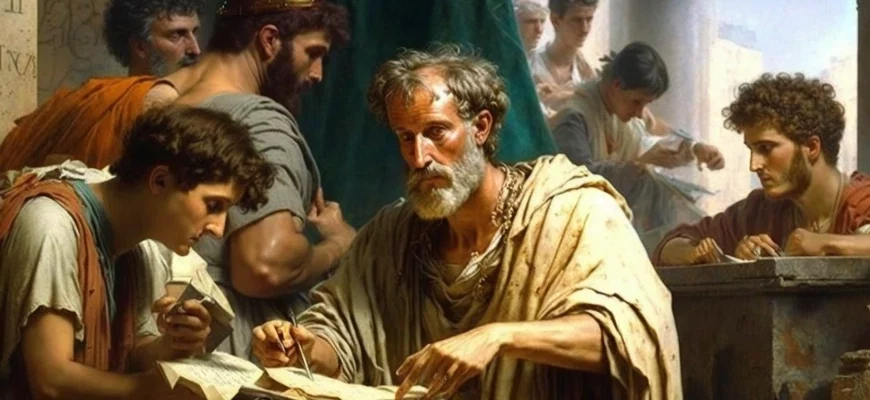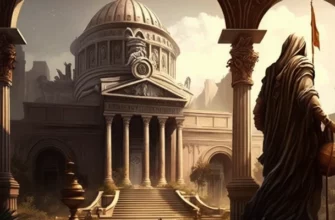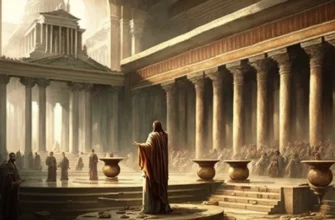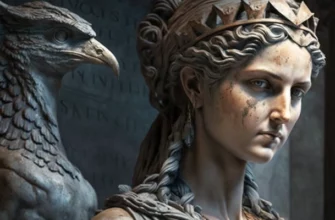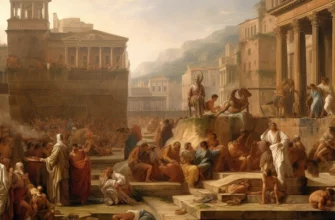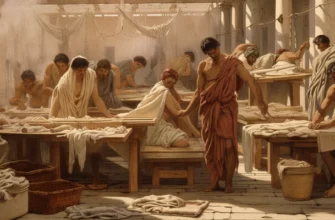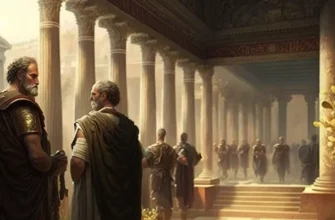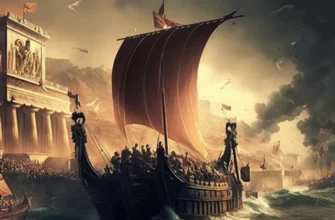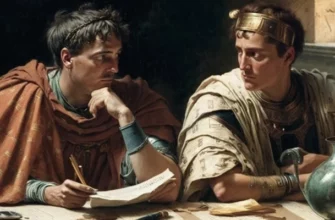Upbringing, education, and science were very important aspects of life in Ancient Rome.
The upbringing of Roman children began at an early age and was aimed at fostering moral qualities such as honesty, responsibility, and discipline. Parents most often carried out this upbringing themselves or hired tutors to help with their children’s education.
Education in Ancient Rome was intended for the upper class of society, who usually held high positions in the government and had considerable financial resources. Education consisted of grammar, rhetoric, and philosophy, as well as the study of history and law. Teachers were usually Greeks who had higher education and knowledge of the Greek language.
Science in Ancient Rome developed in various fields, including mathematics, astronomy, medicine, and engineering. Many Roman scientists, such as Pliny the Elder, Galen, and Vitruvius, were known for their contributions to the development of science at that time. The architect and engineer Marcus Vitruvius also made a huge contribution to the development of science by writing the book “On Architecture.”
Overall, upbringing, education, and science were important aspects of Roman society that contributed to the development of people’s intellectual abilities and helped them achieve success in various fields.
The education system in Ancient Rome
The education system in Ancient Rome was complex and varied according to the level of education and social status of the students.
Children from wealthy families most often received a private education. They had a personal tutor who taught them grammar, rhetoric, philosophy, and introduced them to Roman and Greek literature. Students received an individual approach to learning, so their education was quite high.
In poor families, children studied in small local schools, where teachers taught the basics of grammar, mathematics, and elementary knowledge of Roman history and culture.
To obtain higher education, Romans had to enroll in a college, where they were mainly taught Greek philosophy and literature. However, colleges were not accessible to everyone; they were intended for the elite, i.e., those who had sufficient status and money to pay for their education. In colleges, students also studied history, mathematics, astronomy, medicine, and other sciences.
There were also specialized schools in Rome where crafts and professional skills were taught. For example, there were schools for teaching music, dance, martial arts, and other crafts.
In general, the education system in Ancient Rome was, to a certain extent, only accessible to the upper class, but there were certain opportunities for poorer Romans to obtain an education.
Elements of the Roman education system
The elements of the Roman education system in Ancient Rome were:
Grammar – teaching grammatical rules and language, which was very important for cultural and linguistic education.
Rhetoric – teaching the art of persuasion and the ability to speak in front of an audience. The Romans considered rhetoric an important element of power and politics.
Philosophy – the study of philosophical theories and ideas that helped the Romans form their worldview and moral values.
Mathematics – teaching mathematical and geometric principles was important for scientific research and practical work.
History – the study of the history of Rome and other peoples helped the Romans understand their place in the world and develop an awareness of their national identity.
Culture – the study of literature, art, architecture, and other elements of culture helped the Romans develop their taste and artistic potential.
Medicine – the study of medical science and practice helped the Romans maintain their health and fight disease.
Crafts – learning crafts and professional skills was important for ensuring the workforce and developing craft production.
These elements of education were important for the development of Roman society and culture, and helped shape the consciousness and skills of the Romans.
Educational institutions in Ancient Rome
There were various types of educational institutions in Ancient Rome, including:
Grammar schools (ludus litterarius) – these schools were designed for children aged 7 to 12 and provided basic knowledge of reading, writing, and arithmetic. Teachers at grammar schools were usually private tutors who worked in their own homes or in rented premises.
Schools of rhetoric (ludus oratorius) – these schools were the next level of education after grammar schools. Students aged 12 to 16 studied rhetoric and speech to prepare for a professional life in politics, law, or business. Schools of rhetoric were usually private institutions.
Schools of philosophy (academia) – these schools were intended for students aged 16 and older. They offered courses in various fields of knowledge, such as mathematics, philosophy, natural sciences, and history. Tuition was required at these schools, but poor students could receive scholarships.
Law schools (schola forensis) – these schools were designed for the study of law. Students studied various aspects of law and jurisprudence and received training for work in the legal field.
Medical schools – these schools were designed for the study of medical sciences and practice. Students studied anatomy, physiology, and other medical sciences.
Military training schools for young men, which were designed to prepare them for military service. These schools were called ludus gladiatorius or ludus armaturarum, depending on whether they taught bare-handed combat (gladiator school) or weaponry (weapons school).
Schools for children from the upper classes (paedagogium) – these schools were intended for children from the upper classes and provided an extended education in languages, music, dance, and other cultural aspects.
Schools for girls (ludus puellarum) – these schools were intended for girls aged 7 to 12 and included instruction in reading, writing, arithmetic, and housekeeping.
Schools for slaves (ludus servorum) – these schools were intended for slaves, who were taught reading, writing, and arithmetic in order to acquire certain skills for working on their owners’ estates.
It is important to note that most educational institutions taught Latin and Greek, as these languages were important for professional development in Ancient Rome. Many schools were private, but some received support from the state. There were also libraries, which became centers of scientific research and knowledge development.
Philosophy and science in Ancient Rome
Ancient Rome was a very influential civilization that made a great contribution to the development of philosophy and science. Philosophy was widespread among the Romans, especially among the elite classes of society. Many of the most famous Roman philosophers were influential philosophers from Greece, and they tried to distinguish their ideas from those developed by the Greeks.
Among the most famous Roman philosophers are Cicero, Seneca, Epictetus, Marcus Aurelius, and Lucretius. Cicero was one of the most influential Roman philosophers, who tried to combine Greek philosophy with Roman culture and political life.
The Romans were very inventive and progressive in science. They made significant contributions to the development of architecture, engineering, medicine, and mathematics. Many of their inventions and discoveries were very important for the further development of science and technology.
The Romans were also interested in mathematics and astronomy. They used geometry to design buildings and cities, and developed a calendar that was used for decades. Some Roman mathematicians made significant contributions to the development of algebra and geometry, such as Marcus Vitruvius and Lucius.
However, it is worth noting that the Romans had a slightly different approach to science and philosophy than the Greeks. The Romans were more focused on the practical application of knowledge and discoveries than on theoretical musings. They approached science and philosophy from a practical standpoint, focusing on the application of knowledge to solve specific problems.
In the late Roman Empire, there were quite a few philosophical schools and religious movements, such as Stoicism, Epicureanism, and Christianity, which had a significant impact on the culture and thinking of the time. For example, Stoicism was very popular among the Romans and played a significant role in shaping their ethics and morals.
Thus, philosophy and science in Ancient Rome were very important aspects of culture and civilization and made a significant contribution to the development of the world.
Famous Roman philosophers and scientists
There were many prominent philosophers and scientists in Ancient Rome, among whom the following can be highlighted:
Cicero – one of the most famous Roman philosophers, who played an important role in the development of Roman philosophy. He wrote on a wide range of topics, from ethics and politics to religion and law.
Seneca – a Roman philosopher who was known for his works on ethics and morality.
He was also an advisor to Emperor Nero and had a significant influence on the politics of the time.
Epictetus – a Stoic philosopher who preached a simple and moral way of life, which consisted of renouncing material goods and seeking inner happiness.
Lucretius was a Roman philosopher and poet who wrote the famous work On the Nature of Things, in which he expounded his ideas on nature, society, and religion.
Vitruvius was a Roman architect and engineer who played a significant role in the development of architecture and engineering of the time.
He wrote De Architectura, in which he expounded his ideas on the design and construction of buildings.
Galen was a Roman physician and scientist who played a significant role in the development of medicine at that time. He studied the anatomy and physiology of the body and developed new methods of treatment.
Pliny the Elder was a Roman naturalist and historian who wrote Natural History, in which he described many species of animals and plants, as well as other natural phenomena and historical facts. This work is considered one of the most important sources of knowledge about the nature and history of Ancient Rome.
Marcus Aurelius was a Roman emperor and philosopher who was a representative of Stoicism. His philosophical reflections were collected in the book “Meditations,” where he shares his thoughts on morality, ethics, and life values.
Tacitus was a Roman historian who wrote about the history of the Roman Empire.
His works are an important source of information about the political, social, and cultural events of that time.
Plutarch was a Greek philosopher and historian who lived in Rome. He wrote many biographies of prominent Greeks and Romans, including Alexander the Great, Julius Caesar, Marcus Aurelius, and many others. His works are an important source of knowledge about the history of Ancient Rome and Greece.
These philosophers and scholars had a significant influence on the development of Roman culture, science, and philosophy. Their ideas and works are still an important source of knowledge about that time, as well as an inspiration for many contemporary studies in these fields.
Cultural values in Ancient Rome
Ancient Rome was one of the most influential and significant civilizations in world history and was of great importance in the development of culture, art, and literature. The cultural values of Ancient Rome include the following elements:
Art and architecture: Roman architecture is known for its monumental structures, such as the Colosseum, the Pantheon, the Forum Romanum, and others. Roman sculptures are also known for their sophistication and expressiveness.
Literature: Roman literature is known for its epic poems, such as Virgil’s Aeneid, as well as works on love, life, and morality, such as Ovid’s Metamorphoses and Marcus Aurelius’ Meditations.
Language: Latin was the main language in Rome and other Roman provinces. It was used for literary works, administrative documents, and religious texts. Latin is one of the main languages of Western culture to this day.
Religion: Roman religion was polytheistic and included various gods and goddesses associated with different areas of life. Roman religious rituals and festivals have survived to this day and have become part of world culture.
Law: Roman law is considered one of the most important legacies of Ancient Rome. Roman laws were based on the principles of justice and equality before the law, and they were used for many centuries, including in medieval and modern jurisprudence.
Engineering: Roman engineering is known for its technical achievements, such as drainage and water supply, road construction, and bridge building. Roman engineers used innovative technologies and materials that allowed them to build huge structures that have survived to this day.
Culinary arts: Roman cuisine is known for its diversity and use of spices and ingredients. Roman dishes include pizza, pasta, soups, meat dishes, and desserts.
All of these cultural values have become part of world culture and are of great importance today. Ancient Rome has left a global legacy in many areas, which is recognized and honored today.
